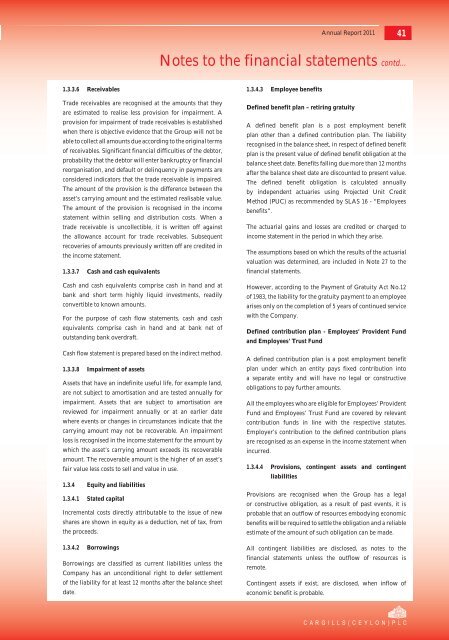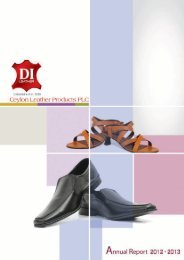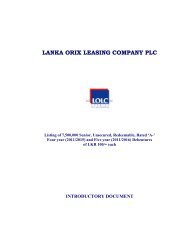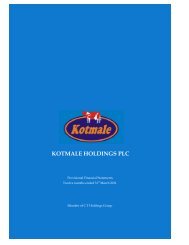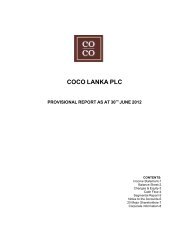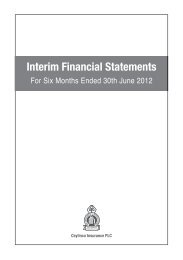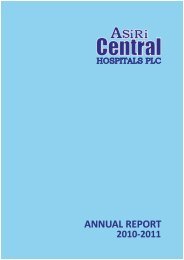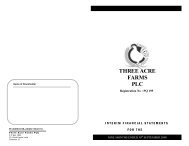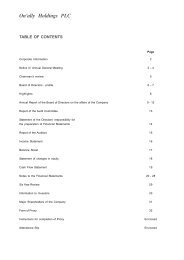2011 Annual Report - Cargills (Ceylon)
2011 Annual Report - Cargills (Ceylon)
2011 Annual Report - Cargills (Ceylon)
You also want an ePaper? Increase the reach of your titles
YUMPU automatically turns print PDFs into web optimized ePapers that Google loves.
<strong>Annual</strong> <strong>Report</strong> <strong>2011</strong>41Notes to the financial statements contd...1.3.3.6 ReceivablesTrade receivables are recognised at the amounts that theyare estimated to realise less provision for impairment. Aprovision for impairment of trade receivables is establishedwhen there is objective evidence that the Group will not beable to collect all amounts due according to the original termsof receivables. Significant financial difficulties of the debtor,probability that the debtor will enter bankruptcy or financialreorganisation, and default or delinquency in payments areconsidered indicators that the trade receivable is impaired.The amount of the provision is the difference between theasset’s carrying amount and the estimated realisable value.The amount of the provision is recognised in the incomestatement within selling and distribution costs. When atrade receivable is uncollectible, it is written off againstthe allowance account for trade receivables. Subsequentrecoveries of amounts previously written off are credited inthe income statement.1.3.3.7 Cash and cash equivalentsCash and cash equivalents comprise cash in hand and atbank and short term highly liquid investments, readilyconvertible to known amounts.For the purpose of cash flow statements, cash and cashequivalents comprise cash in hand and at bank net ofoutstanding bank overdraft.Cash flow statement is prepared based on the indirect method.1.3.3.8 Impairment of assetsAssets that have an indefinite useful life, for example land,are not subject to amortisation and are tested annually forimpairment. Assets that are subject to amortisation arereviewed for impairment annually or at an earlier datewhere events or changes in circumstances indicate that thecarrying amount may not be recoverable. An impairmentloss is recognised in the income statement for the amount bywhich the asset’s carrying amount exceeds its recoverableamount. The recoverable amount is the higher of an asset’sfair value less costs to sell and value in use.1.3.4 Equity and liabilities1.3.4.1 Stated capitalIncremental costs directly attributable to the issue of newshares are shown in equity as a deduction, net of tax, fromthe proceeds.1.3.4.2 BorrowingsBorrowings are classified as current liabilities unless theCompany has an unconditional right to defer settlementof the liability for at least 12 months after the balance sheetdate.1.3.4.3 Employee benefitsDefined benefit plan – retiring gratuityA defined benefit plan is a post employment benefitplan other than a defined contribution plan. The liabilityrecognised in the balance sheet, in respect of defined benefitplan is the present value of defined benefit obligation at thebalance sheet date. Benefits falling due more than 12 monthsafter the balance sheet date are discounted to present value.The defined benefit obligation is calculated annuallyby independent actuaries using Projected Unit CreditMethod (PUC) as recommended by SLAS 16 - “Employeesbenefits”.The actuarial gains and losses are credited or charged toincome statement in the period in which they arise.The assumptions based on which the results of the actuarialvaluation was determined, are included in Note 27 to thefinancial statements.However, according to the Payment of Gratuity Act No.12of 1983, the liability for the gratuity payment to an employeearises only on the completion of 5 years of continued servicewith the Company.Defined contribution plan - Employees’ Provident Fundand Employees’ Trust FundA defined contribution plan is a post employment benefitplan under which an entity pays fixed contribution intoa separate entity and will have no legal or constructiveobligations to pay further amounts.All the employees who are eligible for Employees’ ProvidentFund and Employees’ Trust Fund are covered by relevantcontribution funds in line with the respective statutes.Employer’s contribution to the defined contribution plansare recognised as an expense in the income statement whenincurred.1.3.4.4 Provisions, contingent assets and contingentliabilitiesProvisions are recognised when the Group has a legalor constructive obligation, as a result of past events, it isprobable that an outflow of resources embodying economicbenefits will be required to settle the obligation and a reliableestimate of the amount of such obligation can be made.All contingent liabilities are disclosed, as notes to thefinancial statements unless the outflow of resources isremote.Contingent assets if exist, are disclosed, when inflow ofeconomic benefit is probable.


